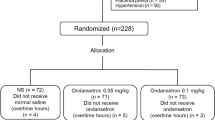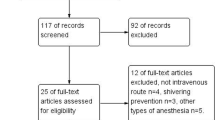Abstract
Objective
Although ondansetron was considered to prevent post-anesthesia shivering during cesarean section, its efficiency remained controversial. Our review was conducted to estimate the efficiency and safety of ondansetron in preventing post-anesthesia shivering during cesarean section.
Methods
The literature were searched from their inception to October 2020 without restriction of language. All randomized controlled trials investigating the efficacy of ondansetron versus placebo in preventing shivering during cesarean section under neuraxial anesthesia were included. The meta-analysis was conducted using Stata software.
Results
Eleven randomized controlled studies with a total of 748 individuals were finally included in our meta-analysis. Our results manifested that intravenous ondansetron compared with intravenous placebo significantly reduced the incidence of post-anesthesia shivering (PAS) (RR 0.53, 95% CI 0.14–0.68). Subgroup analysis according to doses of ondansetron indicated that the efficacy of 4 mg doses of ondansetron (RR 0.37, 95% CI 0.21–0.64) is equivalent to that of 8 mg doses of ondansetron (RR 0.61, 95% CI 0.47–0.81) in preventing PAS. In addition, the intravenous ondansetron led to a lower incidence of hypotension than intravenous placebo (OR 0.47, 95% CI 0.32–0.70). We could not demonstrate differences in the incidence of bradycardia between intravenous ondansetron and intravenous placebo.
Conclusion
Our results found that intravenous ondansetron was effective in preventing shivering during cesarean section under neuraxial anesthesia, and had an advantage in reducing the incidence of hypotension compared with intravenous placebo.





Similar content being viewed by others
References
Boerma T et al (2018) Global epidemiology of use of and disparities in caesarean sections. Lancet 392(10155):1341–1348
The L (2018) Stemming the global caesarean section epidemic. Lancet 392(10155):1279
Hawkins JL et al (2011) Anesthesia-related maternal mortality in the United States: 1979–2002. Obstet Gynecol 117(1):69–74
Wu JM, Hundley AF, Visco AG (2005) Elective primary cesarean delivery: attitudes of urogynecology and maternal-fetal medicine specialists. Obstet Gynecol 105(2):301–306
Finger C (2003) Caesarean section rates skyrocket in Brazil. Many women are opting for caesareans in the belief that it is a practical solution. Lancet. 362(9384):628
Tsai PS et al (2011) General anaesthesia is associated with increased risk of surgical site infection after Caesarean delivery compared with neuraxial anaesthesia: a population-based study. Br J Anaesth 107(5):757–761
Hoefnagel A, Yu A, Kaminski A (2016) Anesthetic complications in pregnancy. Crit Care Clin 32(1):1–28
Practice Guidelines for Obstetric Anesthesia (2016) An updated report by the American Society of anesthesiologists task force on obstetric anesthesia and the society for obstetric anesthesia and perinatology. Anesthesiology 124(2):270–300
Hawkins JL (2007) American society of anesthesiologists’ practice guidelines for obstetric anesthesia: update 2006. Int J Obstet Anesth 16(2):103–105
Crowley LJ, Buggy DJ (2008) Shivering and neuraxial anesthesia. Reg Anesth Pain Med 33(3):241–252
Liu J et al (2019) Comparison of nalbuphine, ondansetron and placebo for the prevention of shivering after spinal anaesthesia for urgent caesarean delivery: a randomised double-blind controlled clinical trial. Int J Obstet Anesth. https://doi.org/10.1016/j.ijoa.2019.10.002
Lopez MB (2018) Postanaesthetic shivering—from pathophysiology to prevention. Rom J Anaesth Intensive Care 25(1):73–81
Nnacheta TE, Onyekwulu FA, Amucheazi AO (2020) Prevention of postanesthetic shivering under subarachnoid block for cesarean section: a randomized, controlled study comparing tramadol versus ondansetron. Niger J Clin Pract 23(5):619–625
Browning RM et al (2013) Prophylactic ondansetron does not prevent shivering or decrease shivering severity during cesarean delivery under combined spinal epidural anesthesia: a randomized trial. Reg Anesth Pain Med 38(1):39–43
Higgins JP et al (2011) The Cochrane Collaboration’s tool for assessing risk of bias in randomised trials. Bmj 343:d5928
Badawy AA, Mokhtar AM (2017) The role of ondansetron in prevention of post-spinal shivering (PSS) in obstetric patients: a double-blind randomized controlled trial. Egypt J Anaesth 33(1):29–33
Moustafa AA, Baaror AS, Abdelazim IA (2016) Comparative study between nalbuphine and ondansetron in prevention of intrathecal morphine-induced pruritus in women undergoing cesarean section. Anesth Essays Res 10(2):238–244
El Khouly NI, Meligy AM (2016) Randomized controlled trial comparing ondansetron and placebo for the reduction of spinal anesthesia-induced hypotension during elective cesarean delivery in Egypt. Int J Gynecol Obstet 135(2):205–209
Rashad MM, Farmawy MS (2013) Effects of intravenous ondansetron and granisetron on hemodynamic changes and motor and sensory blockade induced by spinal anesthesia in parturients undergoing cesarean section. Egypt J Anaesth 29(4):369–374
Xiao F et al (2020) A prospective, randomized, double-blinded study of the effect of intravenous ondansetron on the effective dose in 50% of subjects of prophylactic phenylephrine infusions for preventing spinal anesthesia-induced hypotension during cesarean delivery. Anesth Analg 131(2):564–569
Qian J et al (2020) Does an earlier or late intravenous injection of ondansetron affect the dose of phenylephrine needed to prevent spinal-anesthesia induced hypotension in cesarean sections? Drug Des Dev Ther 14:2789–2795
Nallam SR, Cherukuru K, Sateesh G (2017) Efficacy of intravenous ondansetron for prevention of postspinal shivering during lower segment cesarean section: a double-blinded randomized trial. Anesth Essays Res 11(2):508–513
Ranjbar MS, Sheybani S, Jahanbin F (2018) Prophylactic effects of ephedrine, ondansetron and ringer on hemodynamic changes during cesarean section under spinal anesthesia—a randomized clinical trial. Ginekol Pol 89(8):453–458
Schäfer M, Kunitz O (2002) Postoperative shivering. Anaesthesist 51(9):768–784
Horn EP et al (1999) Postoperative pain facilitates nonthermoregulatory tremor. Anesthesiology 91(4):979–984
Sessler DI (2008) Temperature monitoring and perioperative thermoregulation. Anesthesiology 109(2):318–338
Alfonsi P (2003) Postanaesthetic shivering. Epidemiology, pathophysiology and approaches to prevention and management. Minerva Anestesiol 69(5):438–42
Dawson NJ, Malcolm JL (1982) Initiation and inhibition of shivering in the rat: interaction between peripheral and central factors. Clin Exp Pharmacol Physiol 9(1):89–93
Ryu C et al (2019) Vasopressors for the management of maternal hypotension during cesarean section under spinal anesthesia: a systematic review and network meta-analysis protocol. Medicine 98(1):e13947
Zhou C et al (2018) Efficacy of ondansetron for spinal anesthesia during cesarean section: a meta-analysis of randomized trials. J Int Med Res 46(2):654–662
Funding
This research was carried out without funding.
Author information
Authors and Affiliations
Corresponding author
Ethics declarations
Conflict of interest
The authors declare that they have no conflict of interest.
Ethical approval
This article does not contain any studies with human participants or animals performed by any of the authors.
Additional information
Publisher's Note
Springer Nature remains neutral with regard to jurisdictional claims in published maps and institutional affiliations.
Rights and permissions
About this article
Cite this article
Zheng, G., Zhang, J., Liu, J. et al. A meta-analysis of randomized controlled trials: efficiency and safety of ondansetron in preventing post-anesthesia shivering during cesarean section. Arch Gynecol Obstet 307, 223–231 (2023). https://doi.org/10.1007/s00404-022-06523-2
Received:
Accepted:
Published:
Issue Date:
DOI: https://doi.org/10.1007/s00404-022-06523-2




